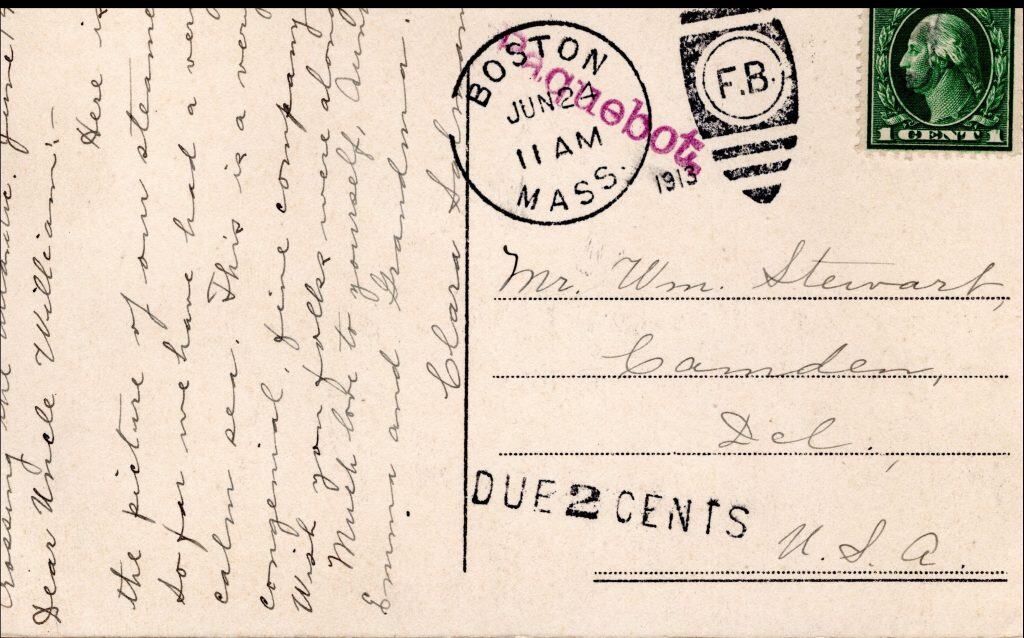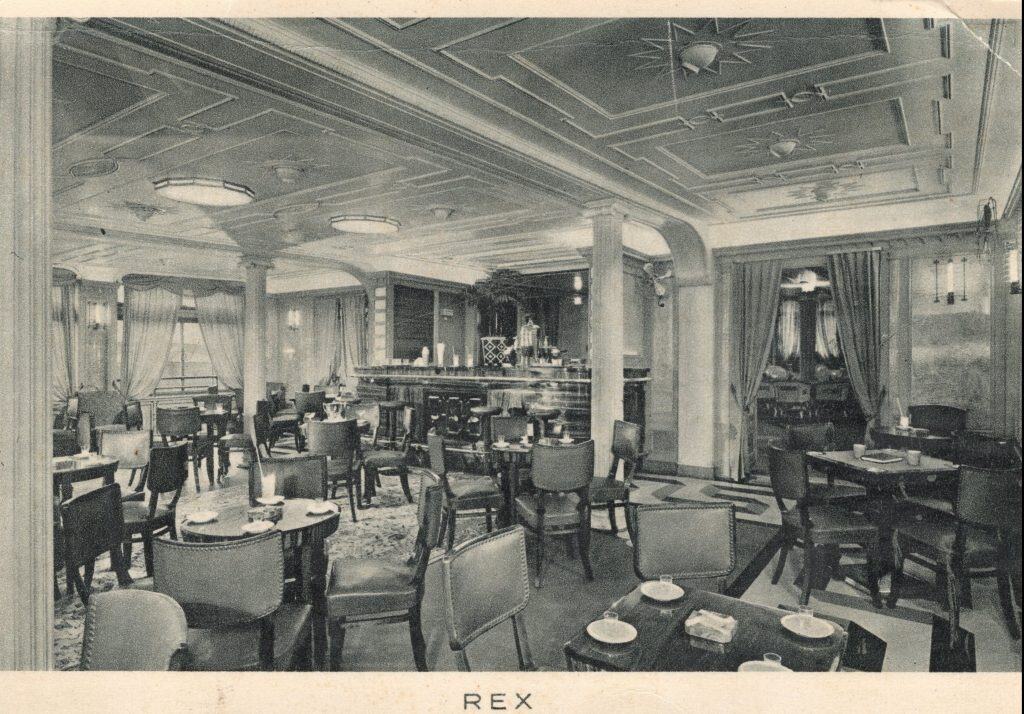At the Chicago World’s Fair in 1893, many who made the trip were excited by the line of Official Souvenir Postal Cards sold by the U. S. Post Office Department. The cards had imprinted postage and popularized the idea of picture postcards.
Within a decade, there were over thirty shipping companies operating passenger liners across the North Atlantic, and other oceans were similarly served. Ship owners commissioned paintings that depicted their vessels, as well as the routes they travelled, their exotic destinations, and life onboard.
Shipping company executives recognized that the new cards would develop into a “Golden Age,” and they decided to print these paintings on postcards. They knew the value of having a ship leave its home port with a stock of postage stamps and picture postcards showing the vessel on which the passenger was travelling would be popular. By selling these at sea, not only would the passenger enjoy sending a postcard, but it would show the ship they were on. Having such cards in the U. S. Mail would also be free advertising for the shipping line and the vessels they operated.
Among many other passenger services, Holland Amerika, P & O, Cunard, White Star, Dollar Line, and Hamburg Amerika were some of the companies that make postcards available from a ship’s purser.
Some were beautifully drawn and colored, depicting glamorous travel and ships. Other showed foreign ports and sights from the ship’s voyages around the world.
Some were black and white prints of the ship, or its interior spaces.
In later years, glossy, colored photographs of the ships were common. Mail from passengers or crew was posted “at sea” and was held by the purser until the next port with a postal facility. The purser himself delivered all mail from the ship to the local post office. [Frequently, a ship’s purser was a sworn, International Postal Union officer.]
If the stamps on the ship’s mail were foreign to the host country, the local post office was required to use a special paquebot postmark or apply the word “PAQUEBOT” to the envelope in ink or with a rubber stamp.

This example of a postcard with a PAQUEBOT marking is from Boston. The mail was then processed by that country’s postal service for delivery to the destination address.
Under Universal Postal Union rules from 1891 and 1897, and last updated in 1974, mail posted on the high seas aboard ocean going vessels is considered the same as posting mail on land in the country of the ship’s registry. This applies since a ship on the high seas is sovereign national territory of that country. Mail is franked with stamps in accordance with the postal rates of the country of the ship’s registry. If the vessel is in port when the postcard or letter is turned in, it is required to be franked with the stamps of the country in whose waters the vessel is located.
The other type of mail that is no longer in use is Seapost mail. Starting in the late nineteenth century, some countries with large merchant fleets carried government post offices on larger passenger ships that provided all the services of a regular post office, including sale of stamps, acceptance of mail and sorting of letters posted during the voyage itself. The list of countries using seaposts included Great Britain, France, Germany, USA, New Zealand, Japan and Italy.

This composite illustrates on-board markings from several different countries. The top is a British Atlantic marking and the next is a US Pacific marking. The Pacific marking was used on the ships of the Dollar Steamship Line, which pioneered around-the-world service and was the largest and most successful company operating the trans-Pacific trade in the 1920s and 1930s. All of the company’s liners were named after US Presidents.
The two-cent red George Washington stamp used on the above 1926 postcard was necessary due to a change in postal rates that took effect on April 1, 1925. To raise more revenue and take advantage of the fashion in sending postcards, the post office increased the rate for postcards from 1 cent to 2 cents, while maintaining the 1 cent rate for government postal cards.
This difference lasted until June 30, 1928, when the rate for all postcards and postal cards were equalized, as seen in the third postcard and that remains in place today.
At the bottom are two joint US-German Atlantic markings. In some cases, two countries cooperated, and staffed ships with employees of both countries.
This occurred with both the German and British post offices for ships operating across the Atlantic Ocean, including White Star Line’s RMS Titanic in 1912. Special Sea Post cancellers were issued to cancel letters or postcards mailed during the voyage. The payment of the postage on vessels leaving the US required American stamps, while on the return trip, the other countries’ stamps were used.
These ship and scenery postcards would be canceled on-board the ship, or with an exotic paquebot postmark from ports around the world. There was a very high count of cards posted between 1900 and 1914 and very high again in the 1930s when shipping lines were at their most active. However, with the advent of air travel in the 1950s and the decline in passenger ships, the sale and use of these cards dramatically decreased.
Some still can be found in the 1960s from the major ships such as the Queen Elizabeth II or the SS United States.

An oversized card showing the Cunard liner Queen Elizabeth, which stopped sailing in 1968. This card was mailed by Abbott Labs of Chicago, a firm that between 1954 and 1968 used more than 190 different card designs to advertise their product – Sodium Pentothal. A story for another time.
For me, there is as much fun studying the address-side as there is on the picture-side. Both sides have a story to tell.






Excellent article! I enjoyed reading about Postcard sent from ships and dreaming about the golden age of travel via luxury liner. Thank you and next time I’m at the Postcard show I will definitely) be checking out some ships cards (and checking both sides).
The introduction, saying “…a century ago it took an International Postal Union to sort out the differences between countries…” makes it sound like there is no longer an organization that does that now. The world still has the Universal Postal Union. It’s an agency within the United Nations that coordinates postal policies among its 192 member nations. Anyone who sends or receives international mail is affected by the UPU and probably doesn’t even know it.
What a interesting and educational article! Thanks Richard, I’ll be looking forward to reading more from you.
Great article! I love looking for cards canceled at sea, as well as ship cancels. It is amazing what the message and the cancel often add to the picture side of the card.
I wonder if anyone ever managed to sail on all of the Dollar liners named after presidents.
Great article on maritime postcards.